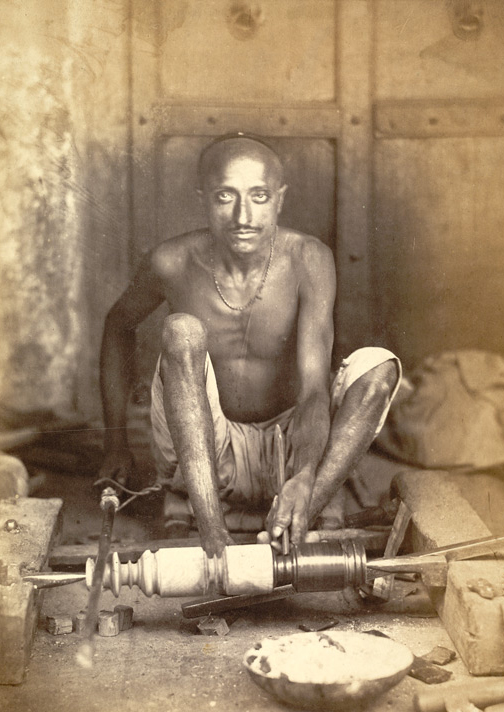After photography was introduced into India in the 1840s it rapidly grew in popularity, particularly as a means to record the vast diversity of people and their dress, manners, trades, customs and religions.
This is a continuation of a series called The Wonderful Artisan, a set of photographs contributed by Shivashankar Narayen in 1870 to the book – “People of India”.
You can see Part 1 here.
09 Women preparing cowdung cakes for fuel, Ahmadabad
Cow dung is collected and made into flat round ‘patties’ which are dried on walls and roofs and then sold as fuel and used extensively on cooking fires and for heating. It has many other uses, including fertiliser and as a flooring material when mixed with mud and water.

10 Gold and silver wire and thread drawers at work

11 A goldsmith’s shop, Bombay
This is one of a series of photographs commissioned by the Government of India in the 19th century, in order to gather information about the different racial groups on the sub-continent. Photograph of a group of goldsmiths (Sonars) seated round a low work table at Bombay in Maharashtra. John Forbes Watson writes: “The Sonar or gold and silversmith is an indispensable member of the Indian social condition of life; and he is to be found in every village, almost in every hamlet, as well as in all towns and cities.

12 Cloth stamper, Western India
Photograph of a cloth stamper seated at a low table on the verandah of a house in Western India. The craft of block printing cotton fabrics is particularly associated with Gujarat. The motifs include flowers, animals, people and abstract designs. The wooden blocks, carved with the design to be printed, have a handle on the back. They are made from woods that are light in weight, gurjun (Dipterocarpus Turbinatus-Gaert) or seasoned teak (Tectona Grandis-Linn); the former wears better when used as a block. Fabrics are still printed this way in India to this day.
13 Preparing sheepskins for tanning, Ahmadabad
A description in John Forbes Watson states, “The process of tanning consists in soaking the skins in lime water for some days to loosen the hair and surface of the skin; the hide is then scraped, and after washing is sewn up in the form of a sack, which is filled with babool bark (Acacia arabica); it is then exposed to a constant stream of water, which forces the astringent matter into the pores of the hide very rapidly; but to make the process still more rapid the hide is taken out, wrung, and refilled every four or five days. While still damp the skins are spread on the ground and rubbed on both sides with a wooden block or mallet furnished with a handle.”
14 Lacquer worker, Western India
The object to be lacquered is turned from hard wood, usually shisham [Dalbergia]or box. After being smoothed and cleaned it is again fixed in the turners’ frame (a kind of lathe worked by hand), and made to rotate. The sticks of lacquer colour (“batti”) consisting of a mixture of lac, resin, colouring matter, and, it is said, a certain proportion of sulphur and bees’-wax, are then applied to the rotating object; the heat produced by friction is sufficient to soften the lacquer composition, which attaches itself to the wood, producing however, a dull and streaky appearance. When sufficient colour has been applied, the surface of the article is skilfully rubbed with a piece of bamboo having a fine edge, by which the colour is evenly distributed, and a polish produced, which is finally completed with oiled rags.
15 Work-box makers, Bombay
The three box makers are shown with examples of their trade, including carved and inlaid boxes and an album cover. A certificate of honorable mention awarded to Framjee Heerjeebhoy at the Paris Exhibition of 1867 is placed in the centre of the photograph. This photograph was probably shown at the Vienna Exhibition of 1873 where Framjee Heerjeebhoy sent many examples of his work. The work exhibited included ivory inlaid inkstands, portfolios, cribbage boards, pocket books and watch cases. He also sent carved sandalwood and ebony work as well as album covers and glove boxes adorned with Delhi pictures, pocket books, paper cutters and watch stands.
And finally an interesting photograph, taken around the same period by Photographer Michie and Company, showing carpet weavers from Karachi jail in Sindh.
































